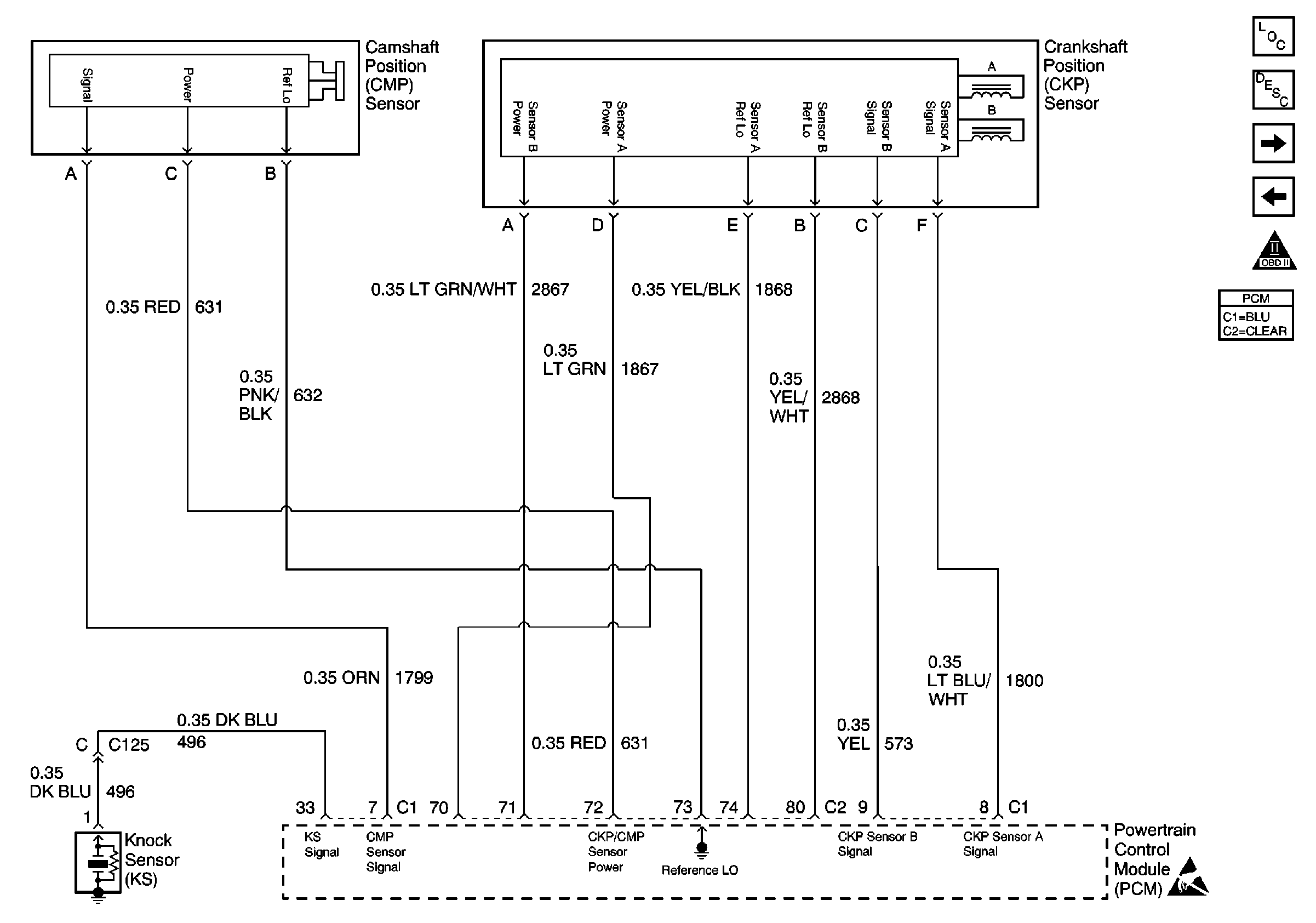Refer to Engine Controls Schematics
Crankshaft and Camshaft Position Sensor

.
Circuit Description
The powertrain control module (PCM) contains integrated knock sensor (KS) diagnostic circuitry. The input signal from the knock sensor is used to detect engine detonation, allowing the PCM to retard ignition control (IC) spark timing based on the amplitude and frequency of the KS signal being received. The knock sensor produces an AC signal under all engine operating conditions. During engine operation, the PCM calculates the average voltage range of the KS signal. If the KS system is operating normally, the PCM should monitor the KS signal voltage varying over 0.5 volt above and below the calculated average range. If the PCM detects that the KS signal voltage remains within the calculated average voltage range, DTC P0327 will set.
Conditions for Running the DTC
| • | The following sensor diagnostic trouble codes (DTCs) are not set: |
| - | AIR sensor |
| - | Vehicle speed sensor (VSS) |
| - | Throttle position (TP) sensor |
| - | Crankshaft position (CKP) sensor |
| - | Mass air flow (MAF) sensor |
| - | Engine coolant temperature (ECT) sensor |
| • | Engine speed is between 1,000 and 3,000 RPM. |
| • | Throttle angle is more than 15 percent. |
| • | Engine load is more than 45 percent. |
| • | Engine coolant temperature is more than 65°C (149°F). |
| • | Maximum spark retard is less than 15 degrees. |
| • | System voltage is more than 9 volts. |
| • | Engine run time is more than 30 seconds. |
Conditions for Setting the DTC
The PCM detects that the KS signal voltage remains within the calculated average voltage range.
Action Taken When the DTC Sets
| • | The PCM illuminates the malfunction indicator lamp (MIL) on the second consecutive ignition cycle that the diagnostic runs and fails. |
| • | The PCM records the operating conditions at the time the diagnostic fails. The first time the diagnostic fails, the PCM stores this information in the Failure Records. If the diagnostic reports a failure on the second consecutive ignition cycle, the PCM records the operating conditions at the time of the failure. The PCM writes the conditions to the Freeze Frame and updates the Failure Records. |
The PCM will use a calculated spark retard value to minimize knock during conditions when knock is likely to occur. The calculated value will vary based on engine speed and load.
Conditions for Clearing the MIL/DTC
| • | The PCM turns the MIL OFF after 3 consecutive drive trips during which the diagnostic runs and passes. |
| • | A last test failed, or the current DTC, clears when the diagnostic runs and passes. |
| • | A History DTC clears after 40 consecutive warm-up cycles, if no other emission related diagnostic failures are reported. |
| • | Use a scan tool in order to clear the MIL diagnostic trouble code. |
| • | Interrupting the PCM battery voltage may or may not clear DTCs. This practice is not recommended. Refer to Powertrain Control Module Description , Clearing Diagnostic Trouble Codes. |
Diagnostic Aids
Notice: Use the connector test adapter kit J 35616-A for any test that
requires probing the following items:
• The PCM harness connectors • The electrical center fuse/relay cavities • The component terminals • The component harness connector
Reviewing the Failure Records vehicle mileage since the diagnostic test last failed may help determine how often the condition that caused the DTC to be set occurs. This may assist in diagnosing the condition.
If the problem is intermittent, refer to Intermittent Conditions .
Test Description
The numbers below refer to the step numbers on the diagnostic table.
-
This step ensures that the malfunction is present.
-
If sent here from symptoms, proceed with the diagnostic table.
-
If the problem persists after replacing the sensor, the PCM may be at fault, however, this is an unlikely failure.
Step | Action | Value(s) | Yes | No | ||||||
|---|---|---|---|---|---|---|---|---|---|---|
1 | Did you perform the Powertrain On-Board Diagnostic (OBD) System Check? | -- | ||||||||
Does scan tool indicate DTC P0327 failed this ignition? | -- | |||||||||
Does the scan tool indicate DTC P0327 failed this ignition? | -- | Go to Diagnostic Aids | ||||||||
4 |
Was a problem found and corrected? | -- | ||||||||
5 | Check the the KS signal circuit for poor connections and terminal tension at the knock sensor and at the PCM. Refer to Testing for Intermittent Conditions and Poor Connections in Wiring Systems. Was a problem found and corrected? | -- | ||||||||
Replace the knock sensor. Refer to Knock Sensor Replacement . Is the action complete? | -- | -- | ||||||||
7 |
Does the scan tool indicate that this test ran and passed? | -- | ||||||||
8 | Review Captured Info using the scan tool. Are there any DTCs that have not been diagnosed? | -- | Go to the applicable DTC table
| System OK |
